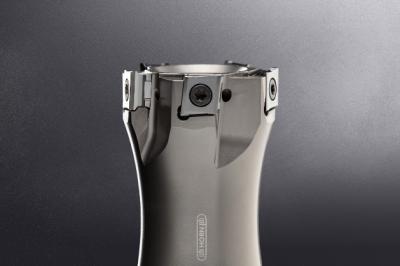
The patented M409 tangential milling system from Paul Horn GmbH excels with its rhombic indexable inserts. The precision-ground inserts achieve a high surface quality at the bottom of the groove and on the flanks. Positive radial and axial rake angles as well as a flank chamfer ensure a stable wedge angle for particularly smooth milling. The system delivers high metal removal rate even with driven tool turrets and on less powerful machines. Together with the internal coolant supply, the tangential milling system covers a wide range of applications and thus increases performance and flexibility.
Especially for milling aluminium alloys and plastics, Horn offers the indexable inserts with polished rake faces on all four edges from stock to counteract the formation of built-up edges. In conjunction with the positive chip breaker geometry, the sharp ground cutting edge produces a soft cut and high surface quality. The special grade is designed for use with the ISO N material group. The inserts can be used in all cutter body variants.
Contact Details
Related Glossary Terms
- alloys
alloys
Substances having metallic properties and being composed of two or more chemical elements of which at least one is a metal.
- axial rake
axial rake
On angular tool flutes, the angle between the tooth face and the axial plane through the tool point.
- coolant
coolant
Fluid that reduces temperature buildup at the tool/workpiece interface during machining. Normally takes the form of a liquid such as soluble or chemical mixtures (semisynthetic, synthetic) but can be pressurized air or other gas. Because of water’s ability to absorb great quantities of heat, it is widely used as a coolant and vehicle for various cutting compounds, with the water-to-compound ratio varying with the machining task. See cutting fluid; semisynthetic cutting fluid; soluble-oil cutting fluid; synthetic cutting fluid.
- gang cutting ( milling)
gang cutting ( milling)
Machining with several cutters mounted on a single arbor, generally for simultaneous cutting.
- milling
milling
Machining operation in which metal or other material is removed by applying power to a rotating cutter. In vertical milling, the cutting tool is mounted vertically on the spindle. In horizontal milling, the cutting tool is mounted horizontally, either directly on the spindle or on an arbor. Horizontal milling is further broken down into conventional milling, where the cutter rotates opposite the direction of feed, or “up” into the workpiece; and climb milling, where the cutter rotates in the direction of feed, or “down” into the workpiece. Milling operations include plane or surface milling, endmilling, facemilling, angle milling, form milling and profiling.
- rake
rake
Angle of inclination between the face of the cutting tool and the workpiece. If the face of the tool lies in a plane through the axis of the workpiece, the tool is said to have a neutral, or zero, rake. If the inclination of the tool face makes the cutting edge more acute than when the rake angle is zero, the rake is positive. If the inclination of the tool face makes the cutting edge less acute or more blunt than when the rake angle is zero, the rake is negative.

